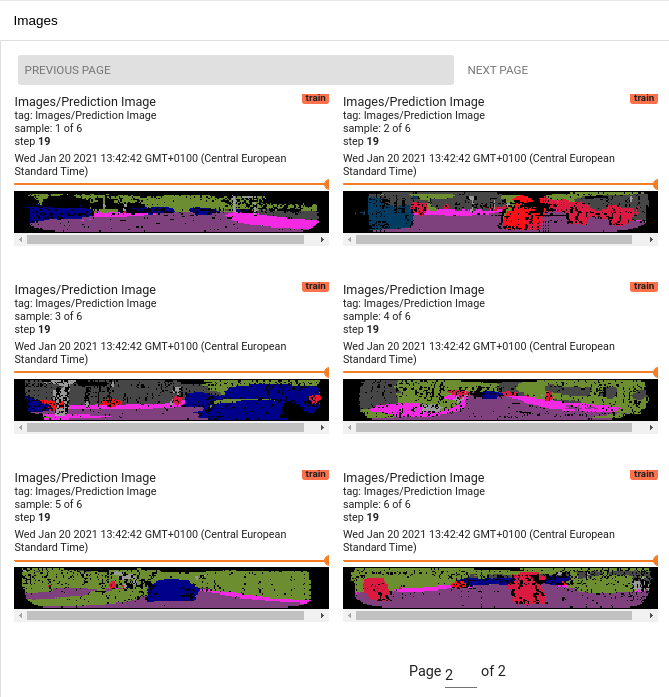Semantic Segmentation of LiDAR Point Clouds in Tensorflow 2.6
This repository contains implementations of SqueezeSegV2 [1], Darknet52 [2] and Darknet21 [2] for semantic point cloud segmentation implemented in Keras/Tensorflow 2.6. The repository contains the model architectures, training, evaluation and visualisation scripts.
Usage
Installation
All required libraries are listed in the requirements.txt file. You may install them within a virtual environment with:
pip install -r requirements.txtFor visualizations using matplotlib, you will need to install tkinter:
sudo apt-get install python3-tk
Data Format
This repository relies on the data format as in [1]. A dataset has the following file structure:
.
├── ImageSet
├── train.txt
├── val.txt
├── test.txt
├── train
├── val
├── test
The data samples are located in the directories train, val and test. The *.txt files within the directory
ImageSet contain the filenames for the corresponding samples in data directories.
A data sample is stored as a numpy *.npy file. Each file contains
a tensor of size height X width X 6. The 6 channels correspond to
- X-Coordinate in [m]
- Y-Coordinate in [m]
- Z-Coordinate in [m]
- Intensity (with range [0-255])
- Depth in [m]
- Label ID
For points in the point cloud that are not present (e.g. due to no reflection), the depth will be zero.
A sample dataset can be found in the directory data.
Sample Dataset
This repository provides a sample dataset which can be used as a template for your own dataset. The directory
sample_dataset a small train and val split with 32 samples and 3 samples, respectively. The samples in the train
dataset are automatically annoated by cross-modal label transfer while the validation set was manually annotated.
Data Normalization
For a proper data normalization it is necessary to iterate over training set and determine the mean and std
values for each of the input fields. The script preprocessing/inspect_training_data.py provides such a computation.
# pclsegmentation/pcl_segmentation
$ python3 preprocessing/inspect_training_data.py \
--input_dir="../sample_dataset/train/" \
--output_dir="../sample_dataset/ImageSet"The glob pattern *.npy is applied to the input_dir path. The script computes and prints the mean and std values
for the five input fields. These values should be set in the configuration files in pcl_segmentation/configs as the arrays mc.INPUT_MEAN and
mc.INPUT_STD.
Training
The training of the segmentation networks can be evoked by using the train.py script. It is possible to choose between
three different network architectures: squeezesegv2 [1], darknet21 [2] and darknet52 [2].
The training script uses the dataset splits train and val. The metrics for both splits are constantly computed
during training. The Tensorboard callback also uses the val split for visualisation of the current model prediction.
# pclsegmentation/pcl_segmentation
$ python3 train.py \
--data_path="../sample_dataset" \
--train_dir="../output" \
--epochs=5 \
--model=squeezesegv2Evaluation
For the evaluation the script eval.py can be used.
Note that for the evaluation the flag --image_set can be set to val or test according to datasets which are present
at the data_path.
# pclsegmentation/pcl_segmentation
$ python3 eval.py \
--data_path="../sample_dataset" \
--image_set="val" \
--eval_dir="../eval" \
--path_to_model="../output/model" \
--model=squeezesegv2Inference
Inference of the model can be performed by loading some data samples and by loading the trained model. The script
includes visualisation methods for the segmented images. The results can be stored by providing
--output_dir to the script.
# pclsegmentation/pcl_segmentation
$ python3 inference.py \
--input_path="../sample_dataset/train/*.npy" \
--output_dir="../output/prediction" \
--path_to_model="../output/model" \
--model=squeezesegv2Docker
We also provide a docker environment for training, evaluation and inference. All script can be found in the directory docker.
First, build the environment with
# docker
./docker_build.shThen you can execute the sample training with
# docker
./docker_train.shand you could evaluate the trained model with
# docker
./docker_eval.shFor inference on the sample dataset execute:
# docker
./docker_inference.shTensorboard
The implementation also contains a Tensorboard callback which visualizes the most important metrics such as the confusion
matrix, IoUs, MIoU, Recalls, Precisions, Learning Rates, different losses and the current model
prediction on a data sample. The callbacks are evoked by Keras' model.fit() function.
# pclsegmentation
$ tensorboard --logdir ../outputMore Inference Examples
 Left image: Prediction - Right Image: Ground Truth
Left image: Prediction - Right Image: Ground Truth
References
The network architectures are based on
- [1] SqueezeSegV2: Improved Model Structure and Unsupervised Domain Adaptation for Road-Object Segmentation from a LiDAR Point Cloud
- [2] RangeNet++: Fast and Accurate LiDAR Semantic Segmentation
TODO
- Faster input pipeline using TFRecords preprocessing
- Docker support
- Implement CRF Postprocessing for SqueezeSegV2
- Implement a Dataloader for the Semantic Kitti dataset
Author of this Repository
Mail: till.beemelmanns (at) ika.rwth-aachen.de
Citation
We hope the provided code can help in your research. If this is the case, please cite:
@misc{Beemelmanns2021,
author = {Till Beemelmanns},
title = {Semantic Segmentation of LiDAR Point Clouds in Tensorflow 2.6},
year = 2021,
url = {https://github.com/ika-rwth-aachen/PCLSegmentation},
doi={10.5281/zenodo.4665751}
}





